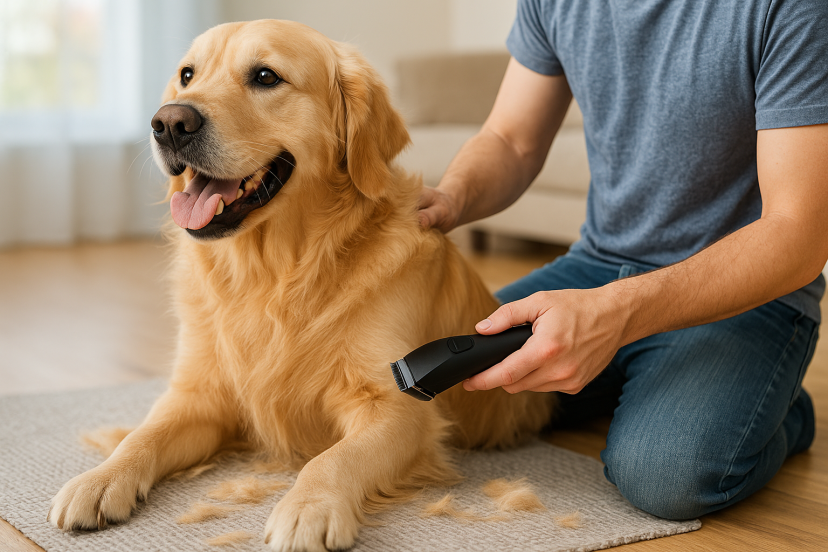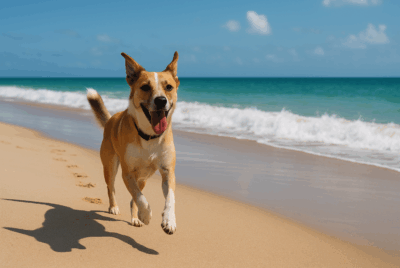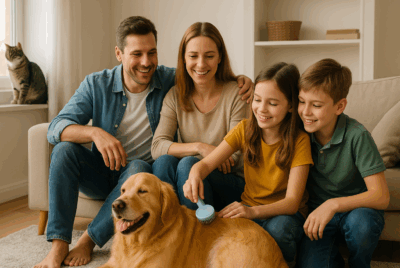Best Pet Grooming Clippers for Dogs: Keep Your Pup Fresh & Happy
We may earn a commission for purchases made using our links. Please see our disclosure for more details.
If you’ve ever tried trimming your dog’s coat at home only to end up with uneven cuts, a nervous pup, or worse—broken clippers that couldn’t keep up—you’re not alone. Finding the right pet grooming clippers for dogs can feel like trial and error, but it doesn’t have to be. In this guide, I’ll walk you through everything you need to know: what to look for, which products actually deliver, and how to make grooming at home a smoother, stress-free experience for both you and your furry friend.
Why Pet Grooming Clippers for Dogs Matter
Dogs aren’t just pets; they’re family. And just like we feel better after a fresh haircut, our pups thrive when they’re comfortable, clean, and tangle-free. Clippers designed specifically for dogs are safer, quieter, and sharper than human clippers, helping you avoid injuries and keep coats healthy.
Signs Your Dog Needs a Trim
Sometimes it’s obvious your pup is due for a grooming session, but other times the signs sneak up on you.
- Matting around ears or belly: These tangles don’t just look messy—they can pull on your dog’s skin and even cause irritation or infection if left too long. I once delayed brushing my Golden Retriever’s ears for a couple of weeks, and the knots got so tight that she winced every time I touched them. That taught me never to let mats get ahead of me.
- Hair covering the eyes or paw pads: When hair falls into your dog’s eyes, it can cause irritation and even affect vision. Long hair between paw pads also traps dirt and moisture, which can be uncomfortable.
- Unpleasant odors: Even after a bath, trapped dirt or debris in long fur can create a smell that won’t go away until trimmed.
- Excessive shedding or overheating: Dogs with long coats may shed more and struggle in warm weather if their fur is too heavy.
💡 Quick tip: Run your fingers through your dog’s coat weekly. If your hand catches on tangles, it’s grooming time.

Key Features to Look for in Dog Clippers
Buying clippers isn’t just about price; it’s about finding the right tool for your pup’s needs.
- Noise level: Some dogs are terrified of loud sounds. Quiet motors can make all the difference in keeping them calm. Think of it like a hairdryer—would you want one that roared in your ear the whole time?
- Blade quality: Stainless steel blades are durable, but ceramic blades stay cooler during long grooming sessions. Picture it like kitchen knives: a cheap blade dulls fast, while a sharp one glides smoothly.
- Corded vs. cordless: Corded clippers give steady power for thick coats, while cordless models are perfect for mobility and smaller breeds.
- Battery life: For cordless models, aim for at least 60–120 minutes of runtime. Nothing’s worse than stopping mid-trim with half a haircut done.
- Attachments: Adjustable guard combs let you switch up coat lengths, so you can give your pup a custom style without mistakes.
Corded vs. Cordless Dog Clippers: What’s the Better Choice?
- Corded: Ideal for large breeds or double coats. You’ll never run out of power, but the cord can feel restrictive.
- Cordless: Perfect for quick trims and small-to-medium dogs. Freedom of movement is a big win, though you’ll need to keep an eye on charging.
Professional Grooming vs. Home Grooming
At first glance, hiring a groomer seems easier. But the costs add up. On average, a grooming session costs $60–$100. If you go every 8 weeks, that’s close to $500–$700 a year. Now compare that to a one-time investment of $75–$150 for high-quality clippers. Within a few months, you’ve already saved money.
But beyond the savings, there’s an emotional benefit. Home grooming means your dog is relaxed in familiar surroundings, without the stress of new people or noisy salons. And each session becomes a bonding ritual—something that strengthens trust between you and your pup.
Product Reviews: Best Pet Grooming Clippers for Dogs
1. Wahl Lithium Ion Pro Series Clippers
- Features: Self-sharpening precision blades, 2-hour battery life, cordless/corded versatility
- Pros: Handles thick coats with ease, professional finish, long runtime
- Cons: Slightly heavy for smaller breeds
- Best For: Medium to large dogs with thick fur
2. Andis UltraEdge Super 2-Speed Clipper
- Features: Two speeds for precision control, detachable blades, shatter-resistant body
- Pros: Extremely durable, ideal for professional-level grooming
- Cons: Corded only, higher upfront cost
- Best For: Breeds with dense or curly coats like Poodles or Doodles
3. Oneisall Dog Clippers Low Noise Rechargeable
- Features: Ultra-quiet motor, rechargeable cordless design, affordable price
- Pros: Great for nervous pups, budget-friendly, beginner-friendly
- Cons: Less effective on very thick or matted coats
- Best For: Small to medium dogs, first-time home groomers
4. Oster A5 Turbo 2-Speed Professional Clippers
- Features: Heavy-duty motor, detachable cryogen-treated blades, professional grade build
- Pros: Built to last, powerful enough for thick double coats
- Cons: Louder than cordless models, heavier design
- Best For: Large dogs, professional groomers, heavy coats
5. Bousnic Cordless Pet Clippers
- Features: Low noise motor, ergonomic grip, USB rechargeable battery
- Pros: Lightweight, comfortable, easy to maneuver
- Cons: Battery may not last for extended grooming sessions
- Best For: Nervous dogs, quick touch-ups, at-home grooming
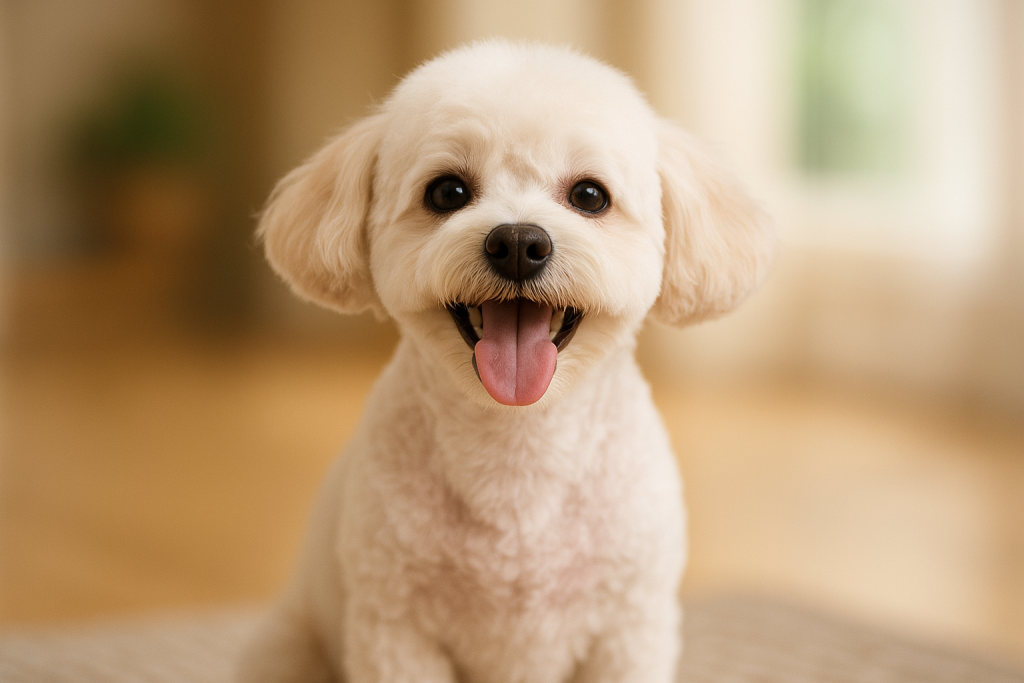
Comparison Table
| Product | Best For | Noise Level | Power | Price Range |
| Wahl Lithium Ion Pro | Medium–Large Dogs | Quiet | Cordless/Corded | $$ |
| Andis UltraEdge | Thick Coats | Low | Corded | $$$ |
| Oneisall Rechargeable | Small–Medium Dogs | Very Quiet | Cordless | $ |
| Oster A5 Turbo | Large Dogs | Moderate | Corded | $$$ |
| Bousnic Cordless | Nervous Dogs | Very Quiet | Cordless | $$ |
Tips for Grooming Dogs at Home
Grooming can feel intimidating, but with the right approach it becomes second nature.
- Brush before clipping: This removes tangles and helps blades glide smoothly. I always start with the sensitive spots—behind the ears and under the belly—because once those are handled, my dog relaxes.
- Start long, then go shorter: Use a longer guard first. You can always trim shorter, but you can’t add hair back.
- Take breaks: Dogs don’t always have the patience for long sessions. A 15-minute pause for play or treats works wonders.
- Keep blades cool: Overheated blades can burn skin. Touch the blade every few minutes; if it feels hot, give it a rest.
💡 Mini challenge: This week, set aside 15 minutes just to brush your dog and handle their paws gently. It’ll make clipping easier when the time comes.
Handling Nervous or Anxious Dogs
Not every pup is a fan of buzzing clippers. Some freeze, while others squirm.
- Gradual introduction: Let your dog sniff the clippers while turned off. Next, turn them on across the room while offering treats. Over time, they’ll learn the sound means something positive.
- Think of it like a vacuum: Just as many dogs bark at vacuums until they get used to them, clippers take time to become “normal.”
- Short sessions: Don’t try to finish everything at once. A few minutes here and there builds trust.
- Cultural note: In some households, grooming isn’t just about looks—it’s part of family bonding. Making it a calm, caring ritual can turn a chore into a moment of connection.
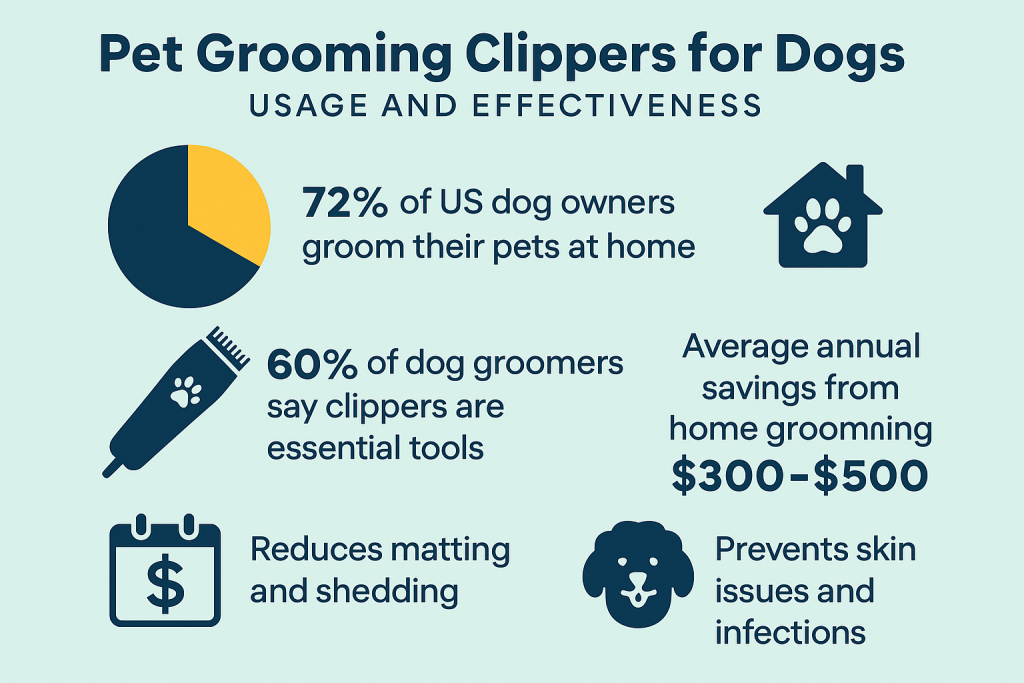
How Frequently Does Your Dog Need Grooming?
Your pup’s grooming schedule varies based on factors like breed, fur type, and local weather conditions.
- Short-haired breeds (Beagles, Boxers): Every 8–12 weeks is enough.
- Medium coats (Spaniels, Shepherds): Every 6–8 weeks helps prevent mats.
- Long-haired or curly coats (Poodles, Doodles): Every 4–6 weeks to stay manageable.
Climate matters too:
- In hot, humid regions, dogs may need more frequent trims to stay cool.
- In colder climates, you may want to keep the coat slightly longer in winter for insulation.
✨ Seasonal tip: Go shorter in summer to prevent overheating but keep trims moderate in winter for warmth.
🧪 Research-Backed Insights
Studies show that regular grooming isn’t just cosmetic—it improves health. A review in the Journal of Veterinary Behavior highlights that positive grooming experiences reduce stress in dogs. Another study from the American Kennel Club emphasizes that proper coat care helps regulate body temperature and prevents infections.
FAQs
What makes dog clippers unique compared to human clippers?
Dog clippers are quieter, sharper, and designed for thicker fur, while human clippers can pull hair and cause discomfort.
Can I use the same clippers on all breeds?
Not always. Thick-coated breeds may need high-powered clippers, while small breeds do fine with lightweight cordless options.
How do I keep blades sharp?
Clean after each use, oil regularly, and store properly. Replace blades when they start tugging hair.
Are cordless clippers strong enough for big dogs?
Some are, especially high-end models. But for large dogs with heavy coats, corded options are often more reliable.
What’s the safest way to groom sensitive areas?
Use lower speeds, keep blades cool, and always move slowly around the face, paws, and belly.
Helpful Resource
If you’re exploring other must-have dog gear, check out these dog booties for outdoor comfort.
Conclusion
Investing in the right pet grooming clippers for dogs means fewer stressful trips to the groomer, more bonding moments at home, and a healthier, happier pup. Start small, stay patient, and you’ll soon find grooming to be a routine your dog actually enjoys.

